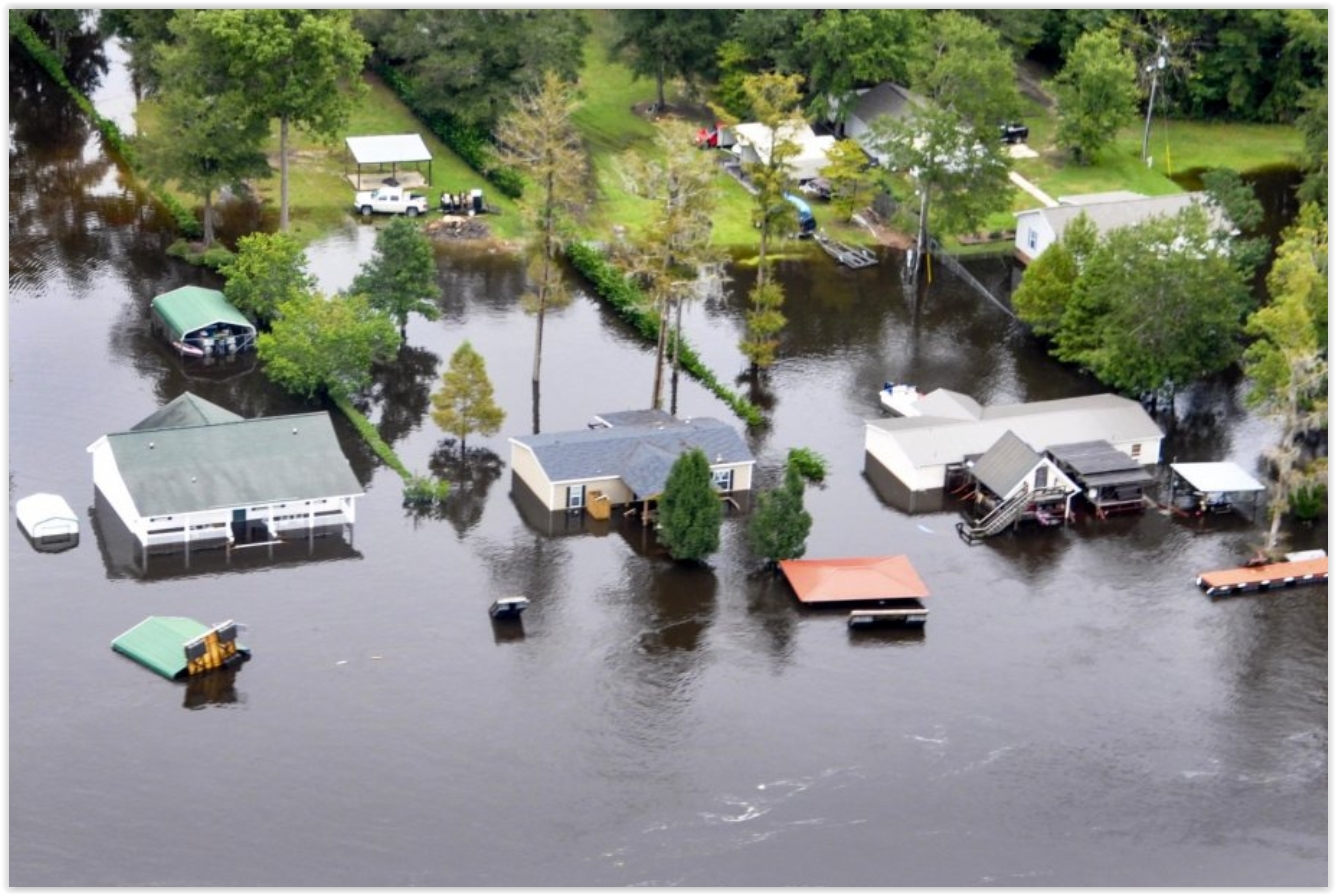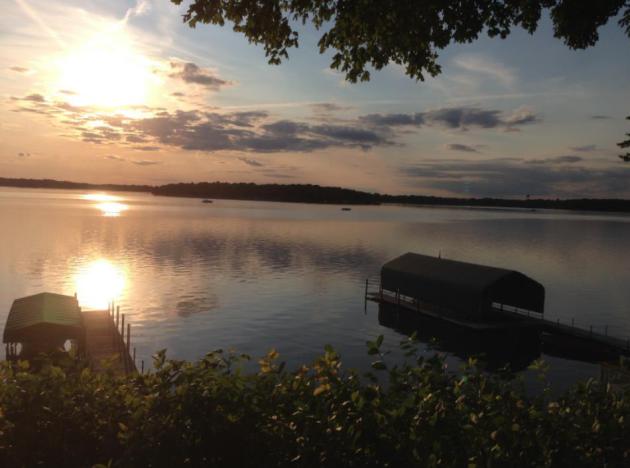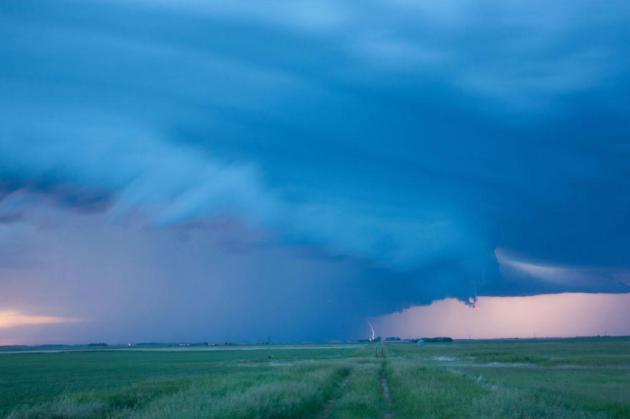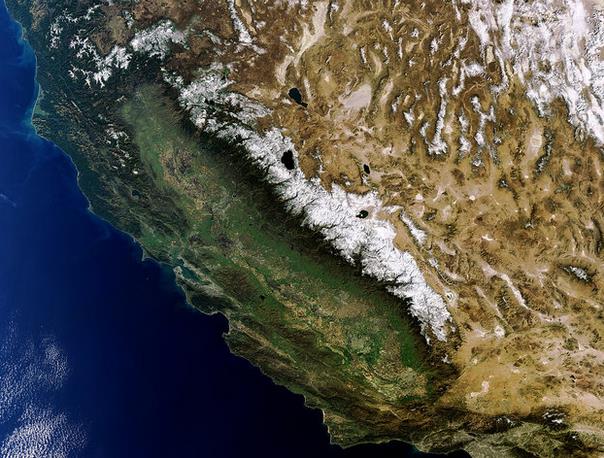77 F. high temperature Wednesday in St. Cloud.
75 F. average high on June 8.79 F. high on June 8, 2015.
June 9, 2002:
Extensive flash flood begins across northwest Minnesota. 14.55 inches
would fall over the next 48 hours near Lake of the Woods. Floodwaters
cover the city of Roseau. The Roseau River looked like a large lake from
a satellite view.
Hot Flash: Weekend Heat Index in the Danger Zone"It’s a sure sign of summer if the chair gets up when you do” wrote Walter Winchell.
I'm
still amazed baking heat is even possible at this northerly latitude.
Just a few months ago people were driving on the lake out back; frozen
ground as rock-hard as a North Dakota drill bit.
It's not necessarily a preview of an inflamed summer to come, but
Friday
WILL take your breath away. Literally. Models suggest low to mid 90s
with a dew point in the mid-70s, creating a Heat Index close to 100F by
late afternoon.
Swamp-like. Florida on a bad day.
The
approach of super-heated air sets off a few morning thundershowers; a
growling reminder that much of the rain falling in June is from
nocturnal thunderstorms: the result of low-level winds interacting with
warm frontal boundaries.
I expect enough sun for mid-80s later today, but 90s are likely
Friday into
Sunday. A feeble frontal passage drops temperatures (slightly) up north
Saturday; weather still looks lake-worthy.
We're still not acclimated to the heat. Take it extra-easy out there, starting
Friday. A taste of Dog Days to come.
4 KM NAM Model: 4 PM Friday.
Check out the predicted surface temperatures at 4 PM tomorrow; close to
100F over west central Minnesota, probably low 90s in the immediate
metro area. With a dew point in the low to mid 70s that could make for
some might-uncomfortable heat indices. Source: AerisWeather.
100-Degree Heat Index Friday Afternoon?
Models are in fairly good agreement, showing a heat index in the
99-102F range by late afternoon tomorrow. Assuming low to mid 90s with a
dew point near 74F that tranlates into a heat index in the danger zone.
Source: Aeris Enterprise.
European Guidance: Hotter Weekend Solution.
The ECMWF model brings a weak frontal boundary south Friday night, with
very slight cooling over northern Minnesota and Wisconsin as surface
winds blow from the east. But the "Euro" lifts that front back to the
north Sunday with more 90s predicted for much of the state. I don't see
any sustained relief until the middle of next week. Graphic:
WeatherBell.
00z NAM Numbers.
Check out the predicted surface temperatures and dew points for Friday
evening and Saturday evening: low 90s wiith dew points in the low to mid
70s - which translates into a heat index close to 100 degrees. The
atmosphere will be juicy and unstable enough for a few T-storms;
guidance prints out .41" by Saturday night when a weak wind shift to the
northeast drops dew points (slightly).
"Unprecedented" Severe Weather Outbreaks Across Central Europe.
My German is a bit rusty, but my 86-year old father was born in Germany
- he's still fluent, and he translated the gist of a story at Germany's
Tagesschau: "
The
headline says 3000 severe weather warnings/alerts in two weeks. The
text says this is unprecedented for central Europe. It never happened
since records were started, which dates back to the late 1800s..."
Attacking Storm Chasers Doesn't Accomplish Anything, And It's Often Misinformed. Here's an excerpt of a retort to a recent Eric Holthaus column from Ian Livington at
Capital Weather Gang: "..
.Chasers, ranks filled with tons of meteorologists, are generally smart folks and excellent risk assessors.
Observers should keep this in mind while continuing to judge us on
safety practices and choices when it comes to proximity to
tornadoes. The well-known chasers who were killed in 2013,
led by tornado researcher Tim Samaras, were giants of the field. But
they chased in a particularly dangerous way while trying to put probes
in front of tornadoes. Most chasers don’t chase that way. And very few
are out there with, as Holthaus calls it, “dollar signs in their eyes, as bystanders’ livelihoods are destroyed...”
The Storm and the Fury: 80 Vintage Photos of Hurricane Seasons Past. NOLA.com in New Orleans has a terrific photo essay; here's an excerpt: "
Bring
up the subject of hurricanes to most residents of South Louisiana, and
killer storms like Betsy in 1965, Camille in 1969 and
She-Who-Shall-Not-Be-Named in 2005 crop up consistently. But time and
again over the decades, the fortitude of locals has been tested by
storms that -- while maybe not as well remembered as those name-brand
milestones -- were still just as life-altering for many local residents.
Time and again, locals have proven equal to the task; Louisianians are
not prone to bowing down in difficult times..."
Photo credit: "
Hurricane Edith, 1971: A Baton Rouge service station found itself scrambled after Hurricane Edith blew though town." (J.W. Guillot / Times-Picayune archive).
With iPhone and Computer Models, Do We Still Need Weather Forecasters?
I'm a bit biased, of course, but I would hope that there's always a
place for context, perspective and analysis, adding value above and
beyond what a computer can do, but who knows? Choosing which model to
believe is another ongoing challenge. Here's an excerpt from
Ars Technica: "...
But
most everybody has looked on their phone or some other device already.
So what am I going to do? Am I just going to rehash everything they
already know?” Many forecasters have been asking themselves this
question lately. Two technologies have converged to rapidly displace the
primary function of meteorologists. First are computers that are
generally better forecasters than humans. For most types of weather,
numerical weather prediction has superseded human forecast methods. And
secondly, thanks to the Internet and increasingly ubiquitous weather
apps on mobile devices, people have continuous, immediate access to
5-day, 7-day or 10-day forecasts. As technology drives automation and
machines take job after job once performed by humans, are meteorologists
next in line?..."
Photo credit: "
James Spann is Alabama's go-to meteorologist when the state's weather turns severe."
Humans Misread Wind Speeds, Skewing a Major Hazards Database. We came along this curious story at
EOS, Earth and Space Science News; here's the intro: "
People may think they know how hard the wind is blowing, but science shows that they usually get it wrong. Researchers have known this for years,
but a recent study seeks to quantify just how bad humans are at
figuring out the speed of wind gusts without the aid of meteorological
instruments. The authors of the study seek to make other researchers
more aware of human bias when using Storm Data, one of the largest
publicly available storm databases. The study,
published in a recent issue of Journal of Applied Meteorology and
Climatology, uses a large-scale statistical analysis of information from
the database to investigate how much storm reporters’ estimates of wind
speeds differ from measurements..."
Photo credit: "
Trained storm reporters learn to use environmental cues, like these swaying trees, to determine wind speeds." Credit:
Pete, via Flickr.
Massive Rehearsal Planned for Northwest Megaquake, Tsunami.
WCBD News 2 has the story - here's an excerpt: "
Imagine
a devastating earthquake and tsunami have cut off Pacific Northwest
coastal communities. Phone and internet service have collapsed. Ham
radio operators living on the stricken coast fire up their radios,
contact emergency managers and report on the magnitude of the disaster
so that no time is wasted in saving lives. This is the kind of scenario
that will be rehearsed during the second week of June in a massive
earthquake and tsunami readiness drill that has been developed by the
U.S. government, the military, and state and local emergency managers
over the past few years to test their readiness for what — when it
strikes — will likely be the nation’s worst natural calamity..."
Image credit: Wikipedia.
An Attack on the Grid? Power Execs Push Back on Koppel Claims.
USA TODAY has the article; here's an excerpt: "
Eight
months after veteran broadcast journalist Ted Koppel published a book
predicting a devastating cyberattack on the U.S. power grid, leaders of
the utility industry are sounding off over what they say is an
exaggerated claim. “We’re speaking out on it now because we think there
is an important story to tell,” Scott Aaronson, the managing director
for cyber and infrastructure security at the Edison Electric Institute,
said last week at a briefing for reporters..."
Jobs Threatened by Machines: A Once "Stupid" Concern Gains Respect.
Is this period of disruption different from previous times when it
comes to employment? I want to be the guy in charge of maintaining the
robots. Here's an excerpt from
The New York Times: "...
If
we are facing a not-so-distant future of robot-fueled growth and rising
potential for mass disemployment, maybe it’s time to start thinking
about how to provide a lot more income that isn’t directly tied to a
job. Jeffrey D. Sachs of Columbia University has been working with a
series of colleagues on an economic model of
a world in which robotization both raises economic output and
immiserates workers, pushing them out of their jobs. It is not a
theoretical impossibility..."
 How One Man Has Explained Almost Every UFO Theory
How One Man Has Explained Almost Every UFO Theory. Here's an excerpt from an interesting read at
Atlas Obscura: "...
To
do this, he has combed through decades of supposed UFO sightings,
reading eyewitness testimony and cross-referencing it with mission
logs. In the process, he's come to an interesting conclusion: human
senses, evolved in and trained on (relatively) slow-moving objects,
certain light conditions, and an atmosphere, get thrown into a tizzy
when those conditions change. "Our sensory system is functioning
absolutely perfectly for Earth conditions," says Oberg. "But we're still
a local civilization. Moving beyond our neighborhood has been visually
confusing..."
Photo credit: "The Space Shuttle Endeavor, silhouetted on the mesosphere." (Photo: NASA/Public Domain)
Energy Conscious Buildings Across America.
Why wouldn't you want your appliances, home, office or church to be as
energy-efficient as possible? You'll reduce energy consumption - and
save money in the process. Here's an excerpt from saveonenergy.com: "...The
U.S. population is about 319 million people, and it’s projected to
reach a whopping 400 million by 2051. As our population grows each year,
so does our impact on the environment in a number of dramatic ways.
Americans’ increasing need for energy is certainly an environmental
hurdle we will need to jump over. Fortunately, there are existing
programs that encourage people and companies alike to reduce their
energy consumption. One primary example is Energy Star, which is
administered by the EPA and provides guidance and certifications to
companies demonstrating a desire to control and reduce energy usage..."
Go Inside an Industrial Plant That Sucks Carbon Dioxide Straight Out of the Air. MIT Technology Review has the story; here's the intro: "
Carbon
dioxide emissions must decrease to nearly zero by 2040 if global
warming by the end of this century is to be held to 2 C. But we may well
miss that target. A pilot plant started last fall at Squamish, British
Columbia, is testing a backup plan: sucking carbon dioxide directly out
of the air. Capturing ambient carbon dioxide is a tall order because,
for all the trouble it causes, the greenhouse gas makes up just .04
ercent of the air we breathe..."
Photo credit: "
This pilot plant can capture up to a ton of carbon dioxide per day."
Alaska Air Flights Using Fuel Made from Fermented (Minnesota) Corn.
The Seattle Times has the story; here's a clip: "...
The
biofuel on Tuesday’s flights was developed by Gevo, a company based in
Englewood, Colo. Gevo produces isobutanol — a form of alcohol — at its
fermentation plant in Luverne, Minn., in a manner similar to the
longstanding production of ethanol. It converts the alcohol into
renewable jet fuel at a biorefinery in Silsbee, Texas. At 1:45 p.m.,
Alaska Flight 2 from Seattle to Washington, D.C., took off powered by
the same fuel mix. Alaska has set a goal to use sustainable aviation
biofuel on all flights at one or more of its primary airports by 2020.
The challenge is to produce the biofuel on a large scale and at a price
similar to regular jet fuel..."
Photo credit: "
Resky
Killion, a fueler at Sea-Tac International Airport, watches as fuel
fills tanks on the wing of an Alaska Airlines jet in December 2015." (Ellen M. Banner/The Seattle Times).
The First Woman to Drive Around the World Wore Men's Breeches and Had a Pet Monkey. Well why not? Here's an excerpt of a fascinating read at Atlas Obscura: "...Wanderwell
described particularly grueling driving conditions in India and China.
She wrote about moments when the team used kerosene in place of
gasoline, mixed water and elephant fat for oil, and crushed bananas to
collect grease. In 1924, China was also struck by a civil war which made
gasoline difficult to come by. She wrote how they had to tow and push
the cars through mud and rivers—in Africa, they needed oxen and mules to
tow the vehicles..."
Photo credit: "
Wanderwell was only 16 years old when she joined the global expedition alongside "Captain" Walter Wanderwell."
5 Things Publishers Can Learn From How Jeff Bezos Is Running the Washington Post. Here's an excerpt from an interesting article at NiemanLab: "...The
Post these days sometimes seems like a technology company as much as it
does a news organization, although the focus is on how technology can
serve journalism rather than the other way around. The Post’s website
and mobile apps are a pleasure to use; the apps have been designed to
serve different audiences depending on whether they are traditional Post
readers or are instead interested in a more viral product offered at a
lower price and that omits local news..."
Passenger Drone Taxi Cleared for Take-Off in U.S. Trials.
The idea of a super-sized drone flying me above the traffic snarls on
I-494 sounds pretty good most days. Here's an excerpt from CNET: "A
drone taxi that can carry a passenger has been cleared for take-off
over Nevada. The EHang 184 pilotless passenger drone carries a single
person and has been approved for testing this year in the US. The
Chinese-Built drone stole technology trade show CES 2016 in Las Vegas in January, and it won't have to go far from sin city for tests...."
File photo credit: "
The EHang can travel at about 60mph for 23 minutes on battery power." EHang.

TODAY: Early thunder, sticky with some afternoon sun. Winds: SE 8-13. High: 84
THURSDAY NIGHT: Partly cloudy and muggy. Low: 70
FRIDAY: Partly sunny. Feels like 100F by late afternoon. T-storm risk late. Winds: S 8-13. High: 92
SATURDAY: More sun, still stinking hot. Winds: E 5-10. Wake-up: 74. High: 92
SUNDAY: Free sauna lingers. Late-day thunder? Winds: SW 10-15. Wake-up: 73. High: 94
MONDAY: Wet start, then clearing, less humid. Winds: N 7-12. Wake-up: 75. High: 86
TUESDAY: Plenty of sun, breathing much easier. Winds: E 7-12. Wake-up: 63. High: 78
WEDNESDAY: Showers and T-storms, some heavy. Winds: E 10-15. Wake-up: 60. High: 72
Climate Stories...
Increased Extreme Weather Events Predicted Due to Effect of Climate Change on the Arctic. Here's the intro to a summary at
Common Dreams:
"The effects of climate change on the Arctic — including melting ice
and sea level rise — may possibly alter weather patterns in the northern
hemisphere. These effects could include hotter, drier summers in some
areas, wetter summers in other areas, and cold, stormy winters in
others, according to studies compiled by the Greenpeace Research
Laboratories in the report, “
What happens in the Arctic doesn't stay in the Arctic” which is published today...."
Unabated Global Warming Threatens West's Snowpack, Water Supply. InsideClimate News has the story; here's an excerpt: "
Low-elevation
snowpack across the Rocky Mountains, the Sierra Nevada and the Cascades
will disappear in the coming decades if global warming continues
unabated, according to a new study. The changes will cause water shortages in the region and dry out forests and grasslands, the study's authors say.
According to the research, the snow line—the altitude above which it
snows, and below which it rains—will climb as much as 800 feet in the
Colorado Rockies, and 1,400 feet in the Rockies of Idaho and Wyoming by
2100 if greenhouse gas emissions continue at the current rate..."
Climate Change Will Affect Farmers' Bottom Line. Here's a clip from a story at phys.org: "...What's
new about the work is that the team used an economic model that allowed
them to look across production systems, so they could evaluate farmland
values for soybean producers and cattle ranchers alike. The model,
knows as the Ricardian approach, also allowed for adaptation on the part
of the farmer. "Farmers are smart; you can't assume that in 100 years
they're going to still be farming corn like they are now,' Dall'Erba
says. "Climate is changing, new practices and new technologies develop,
so they may switch to another production system. The Ricardian approach
assumes farmers will adapt..."
Photo credit: "Southwestern US farmland values will change with changing climate." Credit: Katelina Creative commons CC0 Public Domain.
China Says Important Glacier is Melting Due to Climate Change. Here's a story excerpt from Reuters: "A
glacier that is one of the largest at the source of China's Yangtze
River is fast retreating because of climate change, state media said.
The Jianggudiru Glacier on Geladaindong Mountain in a remote part of
the western province of Qinghai has shrunk 34 meters (38 yards) over the
past six years, Pu Jianchen, a researcher at the Chinese Academy of
Sciences, told the Xinhua news agency.
The glacier started to shrink slowly in the 1970s, then expanded
between 1989 and 1994 before retreating more quickly from 1995, Pu said,
Xinhua reported late on Tuesday..."
Photo credit: "A man stands near the Jianggudiru Glacier on Geladaindong Mountain, in Qinghai-Tibet Plateau, China, September 1, 2006." Reuters/Stringer.
 Is Your House Causing Global Warming? Seeker.com
Is Your House Causing Global Warming? Seeker.com has an interesting post; here's an excerpt: "..
.In today's DNews special, Trace Dominguez
considers the matter of air conditioners and other home appliances, in
regard to energy usage. Reducing energy waste in the home is a fast and
simple way to increase efficiency, save money, and -- while you're at it
-- confront the single most lethal crisis
our species has ever faced. What's not to like? Let's start with a
little quick math -- don't worry, it only stings for a second: According
to the U.S. Energy Information Administration, the average annual energy consumption for a residential home is 15,497 kilowatt-hours
(kWh). About one third of U.S. homes still use coal to generate those
kilowatts. It takes 1.04 pounds of coal to generate one kilowatt-hour,
which also generates 2.13 pounds of carbon dioxide..." (File image: Midwest Energy News).
Ontario To Spend Billions To Fight Climate Change, Offer Incentives. Details via
The Sudbury Star: "
Ontario's
action plan on climate change will include financial incentives to get
cleaner, more efficient cars and trucks on the roads and to convince
homeowners and businesses to lower their carbon footprints, The Canadian
Press has learned. The plan, scheduled to be released on Wednesday,
calls for government spending of $5.9 billion to $8.3 billion on climate
change initiatives over the next five years. The money would come from
the $1.9 billion the Liberal government expects to raise each year by
auctioning off pollution emission credits when Ontario joins a
cap-and-trade market with Quebec and California next January..."
 Editorial: Cities, Counties Must Deal With "New Normal" of Rain, Floods
Editorial: Cities, Counties Must Deal With "New Normal" of Rain, Floods. Here's an excerpt of an Op-Ed at the
Beaumont Enterprise in Texas: "...
Places
in Houston have had two "500-year floods" this spring. The city of
Brenham has already set a record for its wettest calendar year on
record. This week it got more than 19 inches of rain in 48 hours. That's
more than Los Angeles is supposed to get in an entire year. Half of our
entire state is under flash flood watch or warning. Keep in mind that
all of this has no connection with the "official" hurricane season,
which began this week. Our rainfall isn't cascading in from the Gulf of
Mexico. It's coming inland along the same patterns our parents and
grandparents dealt with - only more often, and heavier. After a while,
conditions like this aren't abnormal. They become the new normal, and we
have to start adjusting to them..." (File photo: U.S. Coast Guard).
Tropical Storm Colin 2016. Here's an excerpt from
Climate Signals: "
Tropical
Storm Colin formed five days into the Atlantic hurricane season, just
as Tropical Storm Bonnie, which had arrived five days ahead of the
season's official start, dissipated. Colin marks the earliest arrival of
the third tropical storm in the Atlantic hurricane season, thanks to
unusually warm waters that have helped to fuel the early season storms.
Global warming has been found to increase the rainfall associated with
hurricanes. In addition seal level rise is elevating the storm surge
driven by hurricanes. There is also a significant risk that ocean
warming may be directly increasing hurricane intensity..." (Visible loop: WeatherTap).
That 70s Myth - Did Climate Science Really Call for a "Coming Ice Age?" Ars Technica has the story; here's the intro: "
One
of the undying, zombie-like arguments against climate change is that
you can’t trust climate scientists because they started out making doom
and gloom claims about global cooling in the 1970s. But this, along with
many other things comedian Dennis Miller has said
on late night talk shows, needn’t be taken seriously. By the time fears
of an ice age reached the public's attention, there was a long history
of concerns about warming. The idea that burning fossil fuels would warm
the planet can be traced back to an 1896 paper by Swedish scientist Svante Arrhenius. In the 1930s, Britain’s Guy Callendar concluded
that global warming was already underway. So it seems a bit odd that
anyone worried about cooling. What was really going on back in the
'70s—both in science and in the media?..."
Image credit:
Ravi Kochhar
Guest Post: Attributing Changes in Regional Rainfall to Human Activity.
Carbon Brief has the article; here's a link and excerpt: "...
But
simply waiting for models and observations to get better seems an
insufficient response to the climate changes that are already happening.
In our study, we discuss how new ways of identifying changes in
regional rainfall are beginning to show some success, even in the
presence of imperfect models and measurements. Growing scientific
understanding of the physical processes at play, together with
fine-detailed models, are allowing scientists to compare models and
observations in a way that can disentangle the thermodynamic and dynamic
aspects of the changes. This is a way forward to facilitate detection
in the face of uncertainty..." (File photo: Reuters, TPX Images).
The Great Barrier Reef: a Catastrophe Laid Bare.
The Guardian has the story; here's the intro: "
Australia’s
natural wonder is in mortal danger. Bleaching caused by climate change
has killed almost a quarter of its coral this year and many scientists
believe it could be too late for the rest. Using exclusive photographs
and new data, a Guardian special report investigates how the reef has
been devastated – and what can be done to save it..."



No comments:
Post a Comment